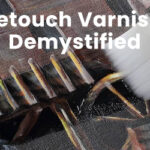Prepare to Sell Your Artwork Using Portfolios For Presenting
As artists we love to create but when it comes to the details of selling we are sometimes a little reluctant. Just in case I get someone who actually wants to know about my work, I have to have an artist portfolio or presentation case to show them.
Recommended for this article: Artist portfolios , Art presentation
For more archival storage to preserve your artwork: Archival storage

By Valry Drake
Whether this person is a potential customer, gallery owner, or just seems interested in art, having information to give them and recording the information you discover about the person is invaluable.
Best Practices For Creating a Portfolio of Your Artwork
First, in order to create a portfolio, you need to have pictures of all your artwork. EVERYTHING you do gets either scanned (at 400 dpi) or digitally photographed and saved your my computer.
Naming of Documents
My documents are named with the name of the painting, size, medium, and date.
On my computer I keep the art in folders by the year of creation.
Have two versions of your portfolio
One is the print version which has the typical photos of my work in acetate page protectors. ALL of the prints are high quality color prints and are consistently on good quality white paper that exactly fits the page protectors. Each print is on the right hand side of the binder and on the left side is an information page. At the front of the binder is a bio with my picture. At the back is an artistis statement.
The other version is a Powerpoint® with all the same stuff. It includes music and smooth transitions between all pages. I have copies of this on storage drives and share files I can easily give it to anyone who is interested. Oh, and of course, it labeled with my contact information clearly printed in large type.
NOTE: Whenever I am displaying my work, teaching a class, or sometimes even when I’m plein-air painting, I have my portfolio (both print and on storage devices) displayed.
Always a good go to: On occasions when I don’t have my portfolio and the conversation turns to art, I at least have a business card with me and my website ready. Yes, I’m sure that hundreds of my business cards are carelessly thrown away at the first opportunity, but you never know.
Keep Careful Records
It’s also important to keep careful records of who we speak with and what we talk about. Include hints about where you met the person, what they looked like, and any personal information you discovered (such as the person loves golf or has twin daughters).
Always ask for a person’s e-mail address and ask if you can include them in your mailing list. A couple of weeks after meeting the person find some excuse to follow up by mail or possibly a phone call.
So why (other than just being OC) do I go to do THIS MUCH work?
Because there are THOUSANDS of artists out there. Competition is steep. If I do not present myself and my product well then I may get overlooked.
Are art purchases based solely on quality? No. Does fame and success come to whoever is worthy? No. If you paint the best painting in the world will someone, somehow barge their way into your studio and fall at your feet weeping and begging to purchase it? No. These are things we all know. It is a rough market out there and we have to work hard to get our little piece of the pie.
Jerry’s carries top quality portfolios and presentation books for my artwork. They have many types that you are sure to find specially made for artists to help make your life easier to sell and preserver your work





